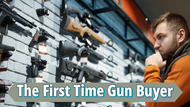A Comprehensive Guide for First-Time Gun Buyers: Choosing the Right Firearm for Your Needs
Posted by Eagle Armorment on Mar 29th 2024
Purchasing a firearm for the first time is a significant decision that requires careful consideration. Whether you're interested in home defense, concealed carry, or recreational shooting, selecting the right firearm is crucial for safety, proficiency, and enjoyment. This guide aims to provide first-time buyers with essential information to make an informed decision when choosing a firearm.
Understanding Your Needs: Before diving into the vast array of firearms available, it's essential to identify your specific needs and intended use for the firearm. Consider factors such as:
- Purpose: Are you buying a firearm for home defense, concealed carry, or recreational shooting?
- Comfort Level: How comfortable are you with firearms? Are you a novice shooter or someone with previous experience?
- Legal Considerations: Familiarize yourself with local laws and regulations regarding firearm ownership, concealed carry permits, and storage requirements.
- Budget: Determine your budget for purchasing a firearm, ammunition, accessories, and training.
Types of Firearms: There are several types of firearms, each with its own characteristics and suitability for different purposes. The most common types include:
Handguns: Handguns are compact firearms designed to be held and operated with one hand. They are popular choices for concealed carry and home defense due to their portability and ease of use.
- Revolvers: Revolvers are known for their simplicity and reliability. They have a revolving cylinder that holds ammunition and typically come in single-action or double-action configurations.
- Semi-Automatic Pistols: Semi-automatic pistols use a magazine to feed ammunition into the chamber automatically after each shot. They offer higher ammunition capacity and faster reloading compared to revolvers.
Rifles: Rifles are long-barreled firearms designed for precision shooting at longer distances. They are commonly used for hunting, target shooting, and home defense.
- Bolt-Action Rifles: Bolt-action rifles require manual operation to chamber each round by cycling the bolt. They are known for their accuracy and reliability.
- Semi-Automatic Rifles: Semi-automatic rifles use gas or recoil operation to automatically cycle the action, allowing for rapid fire. They are versatile firearms suitable for various applications.
Shotguns: Shotguns are firearms that fire multiple projectiles, or shot, with each trigger pull. They are popular for hunting, sport shooting, and home defense.
- Pump-Action Shotguns: Pump-action shotguns require manually cycling the pump to chamber a new round. They are reliable and widely used for home defense.
- Semi-Automatic Shotguns: Semi-automatic shotguns automatically cycle the action after each shot, allowing for faster follow-up shots. They offer versatility but may require more maintenance.
Choosing the Right Firearm: Once you've identified your needs and familiarized yourself with different types of firearms, consider the following factors when selecting the right firearm:
- Ergonomics: Choose a firearm that feels comfortable and natural in your hands. Pay attention to grip size, trigger reach, and overall weight.
- Caliber: Select a caliber appropriate for your intended use and comfort level. Smaller calibers like .22LR are suitable for beginners and recreational shooting, while larger calibers like 9mm and .45 ACP are popular for self-defense.
- Recoil: Consider the recoil of the firearm, especially if you're a novice shooter or have limited upper body strength. Recoil can affect accuracy and comfort during prolonged shooting sessions.
- Size and Concealability: If you're purchasing a firearm for concealed carry, choose a compact and lightweight option that can be easily concealed under clothing without sacrificing firepower.
- Reliability and Durability: Look for firearms from reputable manufacturers known for their reliability and durability. Read reviews and seek recommendations from experienced shooters.
- Accessories and Customization: Consider the availability of accessories and aftermarket parts for your chosen firearm. Accessories like holsters, sights, and magazines can enhance functionality and usability.
Training and Education: Owning a firearm comes with a responsibility to handle it safely and effectively. Invest in proper training and education to develop essential firearms skills, including safe handling, marksmanship, and situational awareness. Seek out certified instructors or enroll in reputable training courses offered by local shooting ranges or firearms organizations.
Choosing the right firearm as a first-time buyer requires careful consideration of your needs, preferences, and intended use. By understanding the different types of firearms, considering key factors such as ergonomics, caliber, and reliability, and investing in proper training and education, you can make an informed decision that ensures safety, proficiency, and enjoyment as a responsible gun owner. Remember to always prioritize safety and adhere to local laws and regulations regarding firearm ownership and use.



